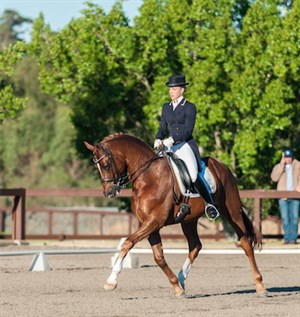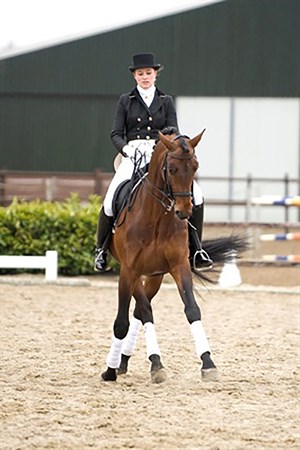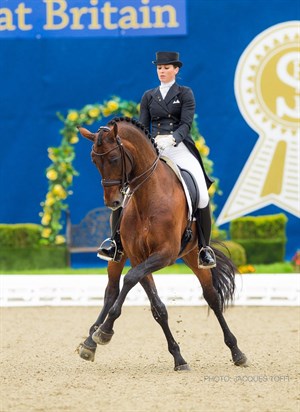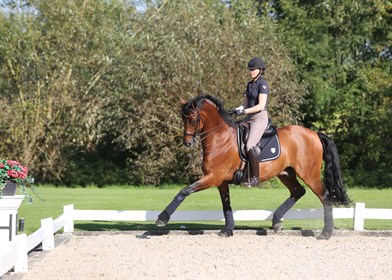
This article has appeared previously with Equestrian Life. To see what's in our latest issue, click here.
Perfect position, Robbie McKinnon and Robali Razzamatazz.
© Franz Venhaus
Ask me what is my favourite movement is and without a second thought I would reply trot half-pass! There is no better feeling than setting up a super half-pass and floating across the arena with good bend and a soft inside rein.
BY LYNDAL OATLEY
EXECUTED WITH BALANCE, precision and expression, a good half-pass can be a highlight of a test at any level. Sandro Boy, of course, has a natural ability for lateral movements, but the level he is able to demonstrate in the arena took several years to develop.
I do not train every day with the degree of impulsion and crossing we demonstrate in the arena. However, when I focus on training the half-pass I always try to play and develop the movement while keeping a happy and sound horse. The well-executed half-pass has lateral reach and elevation of the shoulders as well as a correct cadence and uphill balance. It should demonstrate good lateral reach, freedom of the shoulders to allow greater elevation, and be ridden in an uphill frame with cadence. As the judges’ directive ideas state in the FEI, a half-pass should display "regularity and quality of trot, uniform bend, collection, balance, fluency, and crossing of legs".
With some extra attention to some training techniques, a trot half-pass can be developed with any horse. Here are some suggestions for improving your trot half-pass.
Sandro Boy with his previous owner, 6 months before Lyndal bought him.
© Robert Warmes
Have purpose to your trot
Energy is required in the trot to help your half-pass have sufficient impulsion. To really ride a good half-pass, the horse must be thinking forward and respond to your leg aid without tension or stress. This impulsion and subsequent engagement comes through working on transitions. Utilise your transition in and out of trot, as you go from trot to walk ensure that the weight is carried on the hind legs and the hind leg steps into the transition. When doing the upward transition into trot, make sure your horse responds positively off a light leg aid. If it takes two or three leg aids or a niggle with your spur, the horse is not responsive enough. Using a short, quick double tap behind the girth helps with responsiveness, but it is vital that if the response is positive and thinking forward ? even if it’s canter ? that you reward your horse and let him know he did a good job. Repetition of this responsiveness and the transitions will give you more positive forward energy without you constantly having to create and contain it.
Mix up your trot, playing with the tempo so that you can compress and expand the trot as though squeezing a foam ball. Playing with the transitions in and out of trot and within the trot itself, followed by rewarding your horse with praise, will develop the purpose in your trot and help with your half-pass by creating greater engagement, and thus creating greater balance with the hind legs working more productively to allow the shoulders to be more free and off the forehand.
Sandro Boy in his second International Grand Prix at Horses and Dreams in 2012.
© Jacques Toffi
Utilise your corner
A well-ridden corner is often overlooked, yet is pivotal in setting up for a half-pass, especially in the Grand Prix when the half-pass comes straight out of the corner. Corners are vital to re-balance your horse, ensuring they are pushing from the hind legs and have sufficient softness through the body to be able to move with freedom and elasticity. If your horse is leaning on your inside leg or you have too strong a contact on your inside rein, your half-pass will suffer as a result. When riding the corner, feel as though a barrel is a metre or so inside it and your job is to bend the horse around the barrel, through the corner. Leg-yielding in the corner is useful in ensuring your horse is not leaning on your inside leg. When performing the leg-yield through the corner, check that you have a supple and elastic connection with your inside rein. In training, I check as I ride through the corner that I can give the contact forward and towards the bit whilst keeping a consistent frame. If I can achieve this and have a good feeling off my inside leg through the corner, my half-passes are always better.
Well-ridden corners are pivotal in setting up good half-passes.
© Lyndal Oatley
Where are your horse’s ribs?
My trainer when I was in my teens, Vince Corvi, always stressed the importance of the ribcage, and this technique is still instrumental in my riding, especially in my half-passes. For a well executed half-pass, the horse must be softly bent around your inside leg. Vince always explained it as though your leg is a pillar and you must bend the body around and off your inside leg. This bend around your inside leg shortens the ribcage on the inside and in turn allows greater freedom and expression from the inside shoulder, equaling a better half-pass.
Prepare in shoulder-fore
Leading with the quarters is a common fault of a half-pass and is easily corrected if you prepare in shoulder-fore. Several steps in shoulder-fore ensure a better prepared transition into the half-pass by having the shoulder heading in the correct direction, the bend established, and the inside hind leg under the centre of the body to set up your horse for a good half-pass.
Body control and aids
Balance is essential to creating a better half-pass, and the position of your body instrumental in achieving this. Your body must be slightly turned in the direction you are heading, with increased weight down your inside seat bone and stirrup. By positioning your body in this way you positively influence the half-pass.
This is opposed to a common rider mistake where instead the weight is shifted to the outside seat bone, pushing and thrusting the horse in the direction in which you are heading. This often leads to the inside rein crossing over the neck, or a the very least the rider leaning on it, limiting the freedom of the inside shoulder and as a result leading to a half-pass with less expression and freedom and limited cadence.
Positioning your outside leg slightly back will assist in mobilising your horse’s haunches better. This in turn leads to greater reach and crossover. Freedom of the shoulder allows for greater expression and the ability to ride the forehand upwards, so do not lean on the inside rein. The aim should be to have an elastic inside rein that simply supports your bend and allows the shoulder freedom to reach across. The outside rein should have a more consistent contact, containing the power and the balance in the half-pass.
Mix it up
Play with the half-passes and don't always do it in the same tempo between the same markers. By always testing yourself through riding the half-passes in increased tempo, or slower, steeper, or longer, you will feel where your weaknesses are and can address these better. If the horse is leaning on the inside shoulder and pushing itself across, then correct it. Go straight for a few strides, or even leg-yield a few steps back towards the wall and proceed again in half-pass. Difficulty getting your horse across is often due to the horse being insufficiently responsive to your aids, especially your outside leg.
Go back to basics and ensure your horse is responsive to your aids in transitions and tempo variation and of course, reward it to create a positive association with thinking forward. Adopting leg-yield can help in this scenario, and make your aim to reach the long side earlier, creating a steeper angle and thus improving your horse’s willingness to move sideways. Returning to walk is helpful to reinforce your own feeling and to gain greater control of your aids.
Of course, in the test itself, your goal is a continual angle, frame and bend with a swinging and fluent trot, but to get this you must be able to train your horse with variation to reach the desired result.
Develop your half-pass slowly and gradually
As stated by the FEI, the object of dressage is the harmonious development of the horse into an athlete. This should always remain paramount. Development of a horse and its subsequent training require great attention and responsibility towards proper conditioning of a horse’s muscles to assist in reducing injuries. Dressage horses are prone to ligament and tendon injuries, and lateral movements are a major contributor to lameness due the stress these movements place on the horse’s skeleton and soft tissue from the twisting of the horse and its joints.
Take your time and work slowly towards your goals. You don't have to work on every movement every day. Instead, pick one or two and focus your attention on developing them with patience and calmness. Ensure a proper warm-up before beginning any collected exercise to warm up the body and minimise the risk of injury. Cooling down is also essential, and ice boots or cold water therapy post-workout are a good addition to your routine.
READ THE LATEST NEWS ARTICLES HERE
https://www.equestrianlife.com.au/articles/How-to-improve-your-trot-half-pass_



